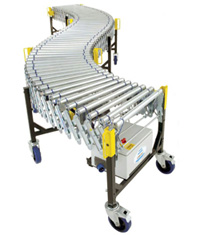The history of conveyor systems is an interesting journey that follows the history of industrial technology. The following will lead you through some of the developments in conveyor systems that mirror developments in American industry.
Early Use of Conveyor Systems
Conveyor systems have been in use for over a century. Farmers used conveyor belts to load grain on ships as early as the late 1700’s. Imagine the farmer’s relief upon reaching the conveyor, after toiling in the fields!
Unlike the highly technical, fluid motion of the conveyors assembled by the Eagle Technologies Group (shown above), early conveyor systems were built using a wooden framework. The belts were made of cloth or rubber. They were used to move large amounts of bulky products, such as crops.
In the early 1900’s factories began to use conveyor systems to move items from one point to another during the material handling.
Engineers developed conveyor systems in the “Roaring 20’s” that could transport goods over longer distances. Cotton and rubber covers were used on conveyors at this time. Underground mines began to utilize conveyor systems to transport coal.
World War II and Conveyor Systems
Conveyors were first made from synthetic materials during World War II; rubber and other natural resources were used to aid in the war effort and could not be spared. Industry began a period of rapid expansion and technological development after World War II, and these changes would be reflected in improved conveyor systems.
Modern Conveyor Systems
During the last forty years, conveyor systems have been continually improved to operate more efficiently and require less maintenance. Conveyor systems today are controlled by computers and automation is used for maximum performance and flexibility.
 Many kinds of conveyor systems exist today. One type is a power and free. These are very versatile and can be used transporting small component like electronic circuit boards or larger components like transmissions and motors. Stations are designed around the conveyors system for assembly processes and testing.
Many kinds of conveyor systems exist today. One type is a power and free. These are very versatile and can be used transporting small component like electronic circuit boards or larger components like transmissions and motors. Stations are designed around the conveyors system for assembly processes and testing.
Conveyors can move heavy loads with accuracy. Continuous motion conveyor systems are used to increase speed and production in various operations. No matter how challenging your automation need may be, a conveyor system can be designed to meet it.

